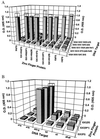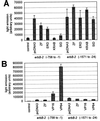Toward controlling gene expression at will: specific regulation of the erbB-2/HER-2 promoter by using polydactyl zinc finger proteins constructed from modular building blocks
- PMID: 9843940
- PMCID: PMC24500
- DOI: 10.1073/pnas.95.25.14628
Toward controlling gene expression at will: specific regulation of the erbB-2/HER-2 promoter by using polydactyl zinc finger proteins constructed from modular building blocks
Abstract
To create a universal system for the control of gene expression, we have studied methods for the construction of novel polydactyl zinc finger proteins that recognize extended DNA sequences. Elsewhere we have described the generation of zinc finger domains recognizing sequences of the 5'-GNN-3' subset of a 64-member zinc finger alphabet. Here we report on the use of these domains as modular building blocks for the construction of polydactyl proteins specifically recognizing 9- or 18-bp sequences. A rapid PCR assembly method was developed that, together with this predefined set of zinc finger domains, provides ready access to 17 million novel proteins that bind the 5'-(GNN)6-3' family of 18-bp DNA sites. To examine the efficacy of this strategy in gene control, the human erbB-2 gene was chosen as a model. A polydactyl protein specifically recognizing an 18-bp sequence in the 5'-untranslated region of this gene was converted into a transcriptional repressor by fusion with Kr uppel-associated box (KRAB), ERD, or SID repressor domains. Transcriptional activators were generated by fusion with the herpes simplex VP16 activation domain or with a tetrameric repeat of VP16's minimal activation domain, termed VP64. We demonstrate that both gene repression and activation can be achieved by targeting designed proteins to a single site within the transcribed region of a gene. We anticipate that gene-specific transcriptional regulators of the type described here will find diverse applications in gene therapy, functional genomics, and the generation of transgenic organisms.
Figures





References
Publication types
MeSH terms
Substances
LinkOut - more resources
Full Text Sources
Other Literature Sources
Research Materials
Miscellaneous

